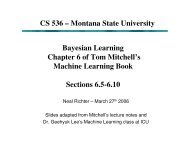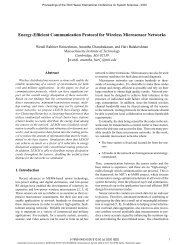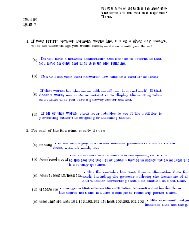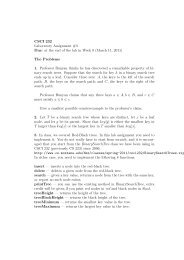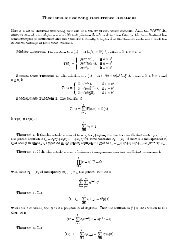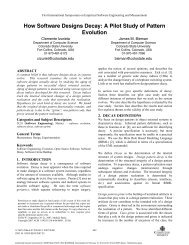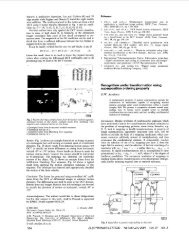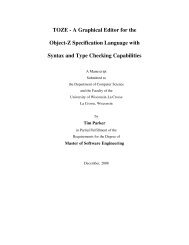Recursion
Recursion
Recursion
Create successful ePaper yourself
Turn your PDF publications into a flip-book with our unique Google optimized e-Paper software.
<strong>Recursion</strong><br />
Chapter 7
Chapter Objectives<br />
• To understand how to think recursively<br />
• To learn how to trace a recursive method<br />
• To learn how to write recursive algorithms and methods<br />
for searching arrays<br />
• To learn about recursive data structures and recursive<br />
methods for a LinkedList class<br />
• To understand how to use recursion to solve the Towers<br />
of Hanoi problem
Chapter Objectives (continued)<br />
• To understand how to use recursion to process twodimensional<br />
images<br />
• To learn how to apply backtracking to solve search<br />
problems such as finding a path through a maze
Recursive Thinking<br />
• <strong>Recursion</strong> is a problem-solving approach that can be used<br />
to generate simple solutions to certain kinds of problems<br />
that would be difficult to solve in other ways<br />
• <strong>Recursion</strong> splits a problem into one or more simpler<br />
versions of itself
Recursive Thinking
Steps to Design a Recursive<br />
Algorithm<br />
• There must be at least one case (the base case), for a<br />
small value of n, that can be solved directly<br />
• A problem of a given size n can be split into one or more<br />
smaller versions of the same problem (recursive case)<br />
• Recognize the base case and provide a solution to it<br />
• Devise a strategy to split the problem into smaller<br />
versions of itself while making progress toward the base<br />
case<br />
• Combine the solutions of the smaller problems in such a<br />
way as to solve the larger problem
String Length Algorithm
Proving that a Recursive Method is<br />
Correct<br />
• Proof by induction<br />
• Prove the theorem is true for the base case<br />
• Show that if the theorem is assumed true for n, then<br />
it must be true for n+1<br />
• Recursive proof is similar to induction<br />
• Verify the base case is recognized and solved<br />
correctly<br />
• Verify that each recursive case makes progress<br />
towards the base case<br />
• Verify that if all smaller problems are solved<br />
correctly, then the original problem is also solved<br />
correctly
Tracing a Recursive Method
Recursive Definitions of<br />
Mathematical Formulas<br />
• Mathematicians often use recursive definitions of<br />
formulas that lead very naturally to recursive algorithms<br />
• Examples include:<br />
• Factorial<br />
• Powers<br />
• Greatest common divisor<br />
• If a recursive function never reaches its base case, a<br />
stack overflow error occurs
Recursive Factorial Method
Recursive Algorithm for Calculating<br />
x n
<strong>Recursion</strong> Versus Iteration<br />
• There are similarities between recursion and iteration<br />
• In iteration, a loop repetition condition determines<br />
whether to repeat the loop body or exit from the loop<br />
• In recursion, the condition usually tests for a base case<br />
• You can always write an iterative solution to a problem<br />
that is solvable by recursion<br />
• Recursive code may be simpler than an iterative<br />
algorithm and thus easier to write, read, and debug
Iterative Factorial Method
Efficiency of <strong>Recursion</strong><br />
• Recursive methods often have slower execution times<br />
when compared to their iterative counterparts<br />
• The overhead for loop repetition is smaller than the<br />
overhead for a method call and return<br />
• If it is easier to conceptualize an algorithm using<br />
recursion, then you should code it as a recursive method<br />
• The reduction in efficiency does not outweigh the<br />
advantage of readable code that is easy to debug
An Exponential Recursive Fibonacci<br />
Method
An O(n) Recursive Fibonacci<br />
Method
Efficiency of <strong>Recursion</strong>:<br />
Exponential Fibonacci<br />
Inefficient
Efficiency of <strong>Recursion</strong>: O(n)<br />
Fibonacci<br />
Efficient
Recursive Array Search<br />
• Searching an array can be accomplished using recursion<br />
• Simplest way to search is a linear search<br />
• Examine one element at a time starting with the first<br />
element and ending with the last<br />
• Base case for recursive search is an empty array<br />
• Result is negative one<br />
• Another base case would be when the array element<br />
being examined matches the target<br />
• Recursive step is to search the rest of the array,<br />
excluding the element just examined
Algorithm for Recursive Linear<br />
Array Search
Implementation of Recursive Linear<br />
Search
Design of a Binary Search<br />
Algorithm<br />
• Binary search can be performed only on an array that<br />
has been sorted<br />
• Stop cases<br />
• The array is empty<br />
• Element being examined matches the target<br />
• Checks the middle element for a match with the target<br />
• Throw away the half of the array that the target cannot<br />
lie within
Design of a Binary Search<br />
Algorithm (continued)
Design of a Binary Search<br />
Algorithm (continued)
Implementation of a Binary Search<br />
Algorithm
Implementation of a Binary Search<br />
Algorithm (continued)
Efficiency of Binary Search and<br />
the Comparable Interface<br />
• At each recursive call we eliminate half the array<br />
elements from consideration<br />
• O(log 2 n)<br />
• Classes that implement the Comparable interface must<br />
define a compareTo method that enables its objects to<br />
be compared in a standard way<br />
• CompareTo allows one to define the ordering of<br />
elements for their own classes
Method Arrays.binarySearch<br />
• Java API class Arrays contains a binarySearch method<br />
• Can be called with sorted arrays of primitive types or<br />
with sorted arrays of objects<br />
• If the objects in the array are not mutually<br />
comparable or if the array is not sorted, the results<br />
are undefined<br />
• If there are multiple copies of the target value in<br />
the array, there is no guarantee which one will be<br />
found<br />
• Throws ClassCastException if the target is not<br />
comparable to the array elements
Recursive Data Structures<br />
• Computer scientists often encounter data structures<br />
that are defined recursively<br />
• Trees (Chapter 8) are defined recursively<br />
• Linked list can be described as a recursive data<br />
structure<br />
• Recursive methods provide a very natural mechanism for<br />
processing recursive data structures<br />
• The first language developed for artificial intelligence<br />
research was a recursive language called LISP
Recursive Definition of a Linked<br />
List<br />
• A non-empty linked list is a collection of nodes such that<br />
each node references another linked list consisting of<br />
the nodes that follow it in the list<br />
• The last node references an empty list<br />
• A linked list is empty, or it contains a node, called the<br />
list head, that stores data and a reference to a linked<br />
list
Recursive Size Method
Recursive toString Method
Recursive Replace Method
Recursive Add Method
Recursive Remove Method
Recursive Remove Method<br />
(continued)
Problem Solving with <strong>Recursion</strong><br />
• Will look at two problems<br />
• Towers of Hanoi<br />
• Counting cells in a blob
Towers of Hanoi
Towers of Hanoi (continued)
Algorithm for Towers of Hanoi
Algorithm for Towers of Hanoi<br />
(continued)
Algorithm for Towers of Hanoi<br />
(continued)
Recursive Algorithm for Towers of<br />
Hanoi
Implementation of Recursive<br />
Towers of Hanoi
Counting Cells in a Blob<br />
• Consider how we might process an image that is<br />
presented as a two-dimensional array of color values<br />
• Information in the image may come from<br />
• X-Ray<br />
• MRI<br />
• Satellite imagery<br />
• Etc.<br />
• Goal is to determine the size of any area in the image<br />
that is considered abnormal because of its color values
Counting Cells in a Blob (continued)
Counting Cells in a Blob (continued)
Implementation
Implementation (continued)
Counting Cells in a Blob (continued)
Backtracking<br />
• Backtracking is an approach to implementing systematic<br />
trial and error in a search for a solution<br />
• An example is finding a path through a maze<br />
• If you are attempting to walk through a maze, you will<br />
probably walk down a path as far as you can go<br />
• Eventually, you will reach your destination or you<br />
won’t be able to go any farther<br />
• If you can’t go any farther, you will need to<br />
retrace your steps<br />
• Backtracking is a systematic approach to trying<br />
alternative paths and eliminating them if they don’t work
Backtracking (continued)<br />
• Never try the exact same path more than once, and you<br />
will eventually find a solution path if one exists<br />
• Problems that are solved by backtracking can be<br />
described as a set of choices made by some method<br />
• <strong>Recursion</strong> allows us to implement backtracking in a<br />
relatively straightforward manner<br />
• Each activation frame is used to remember the<br />
choice that was made at that particular decision<br />
point<br />
• A program that plays chess may involve some kind of<br />
backtracking algorithm
Backtracking (continued)
Recursive Algorithm for Finding<br />
Maze Path
Implementation
Implementation (continued)
Implementation (continued)
Chapter Review<br />
• A recursive method has a standard form<br />
• To prove that a recursive algorithm is correct, you must<br />
• Verify that the base case is recognized and solved<br />
correctly<br />
• Verify that each recursive case makes progress<br />
toward the base case<br />
• Verify that if all smaller problems are solved<br />
correctly, then the original problem must also be<br />
solved correctly<br />
• The run-time stack uses activation frames to keep track<br />
of argument values and return points during recursive<br />
method calls
Chapter Review (continued)<br />
• Mathematical Sequences and formulas that are defined<br />
recursively can be implemented naturally as recursive<br />
methods<br />
• Recursive data structures are data structures that have<br />
a component that is the same data structure<br />
• Towers of Hanoi and counting cells in a blob can both be<br />
solved with recursion<br />
• Backtracking is a technique that enables you to write<br />
programs that can be used to explore different<br />
alternative paths in a search for a solution



